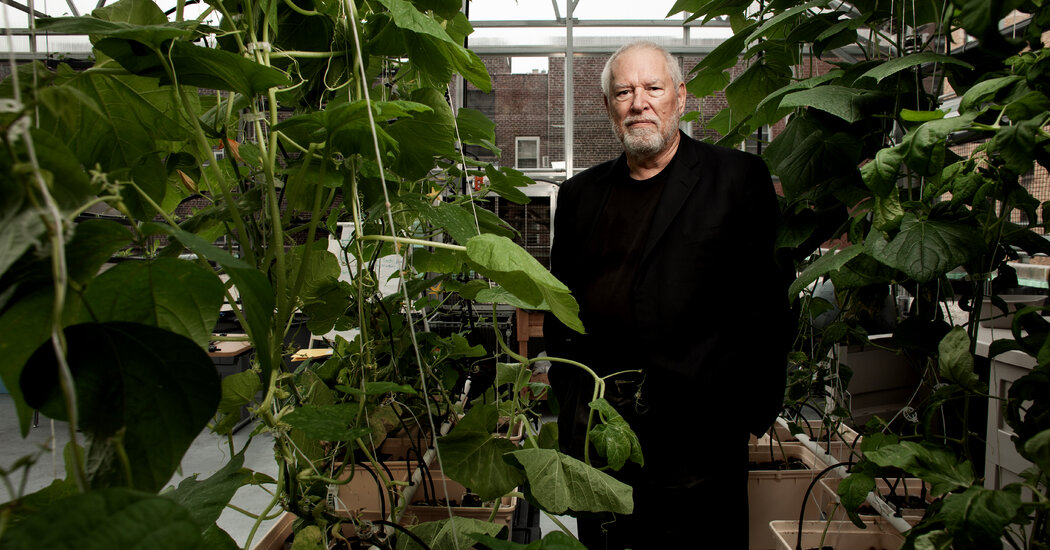Dickson Despommier, a microbiologist who proposed that cities should grow food in high-rises, popularizing the term “vertical farming” — an idea that crossed over from the realm of the purely fanciful to become a reality around the globe — died on Feb. 7 in Manhattan. He was 84.
His wife, Marlene Bloom, confirmed the death, in a hospital. He lived in Fort Lee, N.J.
Dr. Despommier (pronounced de-POM-ee-yay), who was a professor for 38 years at Columbia’s School of Public Health, specialized in parasitic diseases, but he gained far wider influence as a guru of vertical farming.
In 2001, he and students in a medical ecology class designed a 30-story building that theoretically could grow food for 50,000 people. Some 100 varieties of fruits and vegetables would be grown on upper floors, with chickens housed lower down. Fish would feed on plant waste.
Dr. Despommier argued that vertical farms would use 70 to 90 percent less water than traditional farms, allowing agricultural land to return to a natural state and helping to remediate climate change. He evangelized at TEDx talks and in a book, “The Vertical Farm: Feeding the World in the 21st Century.”
“When my book came out, in 2010, there were no functioning vertical farms that I was aware of,” he told The New Yorker several years later. “By the time I published a revised edition in 2011, vertical farms had been built in England, Holland, Japan and Korea.”
Tech investors poured money into vertical farming. The operations generally substituted indoor LED lights for sunlight and used watering systems that spritzed plant roots — no soil needed. The farms sprouted in places as varied as downtown Newark and Dubai, on the Persian Gulf.
The Guardian estimated that there were more than 2,000 vertical farms in the U.S. in 2022, raising vegetables and fruits in stacked trays or long columns, some several stories high, some tended by robots. That year, Walmart announced that it would harvest salad greens from a vertical farm in Compton, Calif., to be run by a company named Plenty.
More recently, the industry has stumbled. High interest rates and energy costs have caused many operations to close or declare bankruptcy. They include the one in Compton and the one in Newark, AeroFarms, which The New Yorker featured prominently in its article about Dr. Despommier in 2017. A company with farms in three Eastern states, Bowery Farming, whose investors included Justin Timberlake and Natalie Portman and which was once valued at $2.3 billion, shut down last year.
Critics questioned if vertical farming really lowers carbon emissions and called it a fad. Others said the industry is merely going through a shakeout and will endure.
Dickson Donald Despommier was born on June 5, 1940, in New Orleans to Roland and Beverly (Wood) Despommier. His father was an accountant for a shipping line. His parents divorced when Dickson was young.
He received a B.S. in biology from Fairleigh Dickinson University in 1962, an M.S. in medical parasitology from Columbia in 1964 and a Ph.D. in microbiology from the University of Notre Dame in 1967.
Dr. Despommier joined Columbia’s faculty in 1971 as an assistant professor of microbiology. He taught a required course in parasitic diseases to second-year medical students for three decades. His research focused on tropical diseases; he was co-author of a textbook, “Parasitic Diseases,” and a director of the website “Parasites Without Borders.”
Besides his wife, he is survived by his sister, Duane Despommier Kuykendall; his sons, Bruce and Bradley; a stepdaughter, Molly Bloom; a stepson, Michael Goodwin; four grandchildren; and three great-grandchildren. An earlier marriage, to Judith Forman, ended in divorce.
The idea of vertical farming emerged when students told Dr. Despommier in 2000 that they were bored with his course on medical ecology. He redirected the semester by posing a question, “What will the world be like in 2050?” and a follow-up question, “What would you like the world to be like in 2050?”
The discussion focused on how densely crowded the planet would be in 50 years and how food would have to be grown then with less water and less pollution from chemical fertilizers. Students said New York City should source all its food from close by. They suggested using the city’s rooftops for agriculture. But then they calculated that if every rooftop in all five boroughs were turned into a garden, the growing acreage would feed only about 2 percent of the population.
Dr. Despommier then thought of raising crops in glass and steel skyscrapers, with plants stacked on multiple levels, just like their human inhabitants. He continued to refine designs with each year’s class of ecology students. In 2001, he adopted the term vertical farming.
After he appeared on the Comedy Central late-night show “The Colbert Report” in 2008 to discuss his eggplants-in-the-sky idea, traffic to his website shot up to 400,000 visitors overnight.
Many of the start-ups that turned Dr. Despommier’s vision into a reality built vertical farms that were only two or three stories high, compared with the 30-story behemoths he had proposed. One was attached to a parking garage in Jackson, Wyo. Others were housed in shipping crates.
But the idea traversed the globe, with a nonprofit, the Association for Vertical Farming, starting up in Germany in 2013.
All along, skeptics questioned whether the cost and the carbon footprint of indoor farming was an improvement over the traditional kind practiced by humanity for some 12,000 years.
“It’s such an appealing idea — ‘Press floor 10 for lettuce’ — that people picked up on it right away,” Bruce Bugbee, a professor of crop physiology at Utah State University, told The New York Times in 2016. “The fundamental problem is that plants need a lot of light. It’s free outside. If we’re going to do it inside, it will require the burning of a lot of fossil fuels.”
The industry shakeout has been brutal, with the editor of the news site Vertical Farming Today declaring in 2023 that venture capital investments in vertical farming had fallen by about 90 percent.
Unfazed, Dr. Despommier kept brainstorming about how modern life could thrive in the face of a dangerously changing climate. In his last book, “The New City: How to Build Our Sustainable Urban Future” (2023), he proposed that cities henceforth be built of wood.
The carbon footprint of making concrete and steel, he explained, is enormous, whereas wood is a carbon sink — trees absorb carbon from the air as they grow — and new technologies for engineering timbers allowed very tall buildings to be built.
“It sounds like we’ll be using up all the wood,” he said last year, “but the fact is that, if vertical farming succeeds, there’ll be a lot more land to grow trees.”


